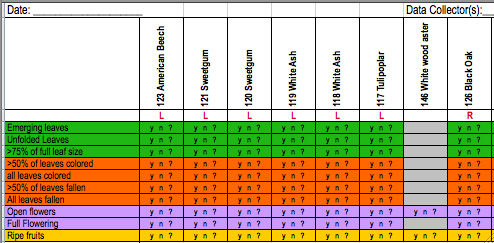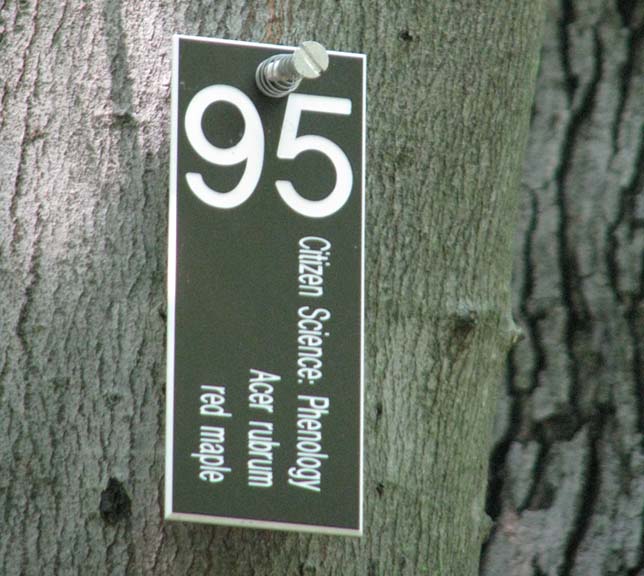What A Citizen Scientist Phenologist Does
Posted in Behind the Scenes, Science on September 13 2011, by Sandy Wolkenberg
Ed. note: Sandy Wolkenberg is a Citizen Scientist who has been working in the Thain Family Forest for three and a half years. Over the course of a week on Plant Talk, Sandy will share a five-part series of posts on The New York Botanical Garden’s Citizen Scientist Tree Phenology Program. If Sandy’s experiences motivate you to want to know more about becoming a Citizen Scientist, check out the Garden’s Volunteer Program page.
As volunteer phenologists, we are tasked with observing and entering data on ten different trees in the Thain Family Forest, usually two or three trees on each of the three Forest trails: The Spicebush, Ridge, and Bridge Trails. We monitor these trees weekly for three seasons, winter being the exception. It was all very new and a little intimidating. Sometimes even finding the trees can be daunting after spring leaves reach full size and each tree’s marker becomes obscured. Each tree in the Citizen Scientist Tree Phenology program is marked with a tag about 6 feet from the ground–these tags correspond to the tree’s numbers on the data entry sheets.
So here, come and meet tree #95, Acer rubrum, the Red Maple:
Tree #95 is one of two red maples that phenologists have been monitoring on the Spicebush Trail, and that Dr. Peters’ monitored for ten years before the Citizen Science Phenology program began. Both of these red maple trees flower each year, but have never produced fruit, those little winged seeds that are such a common sight in late spring or early summer, and are known scientifically as samaras. This is just one of the many mysteries of the Thain Family Forest.
Perhaps the best way to proceed from the tree tag photo is to demonstrate how Citizen Scientists record the tree data we collect. Here is an example of one of the data entry sheets that we fill out each week:

Below you will see a close-up of part of the data entry sheet. Each entry in the left column is a phenophase. As defined by the USA National Phenology Network, a phenophase is, ”an observable stage or phase in the annual life cycle of a plant that can be defined by a start and end point. Phenophases generally have a duration of a few days or weeks, such as the period in which newly emerging leaves are visible or the period in which open flowers are present on the plant.”

Although most collection sheets aren’t quite this colorful, it seems easier to follow and enter data for many trees when the phenophases are in color, i.e., spring in green, fall in orange, flowers in purple, and ripe fruits in yellow. The “L” and “R” delineate on which side of the trail the tree grows.
In Sandy’s next post, the Citizen Scientists set to the task of observing trees.



Dr. Peters is thrilled that the Citizen Science Tree Phenology Program has continued to monitor the behavior of selected trees in the NYBG forest. Keep watching. More phenological mysteries will undoubtedly unfold…